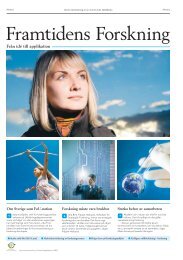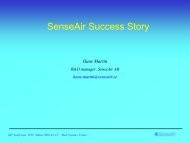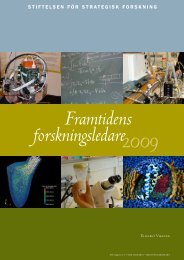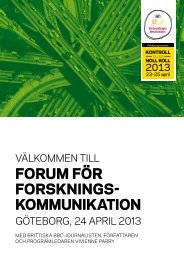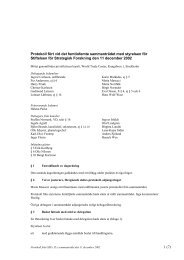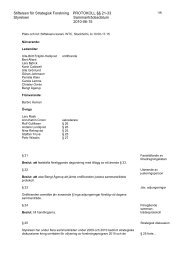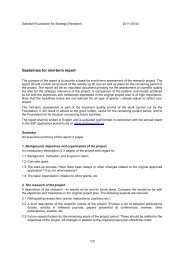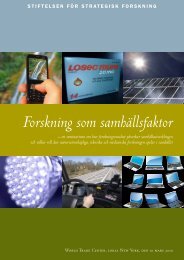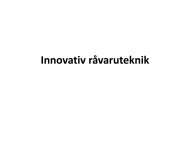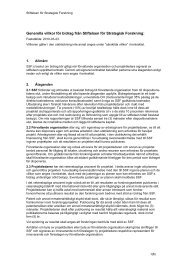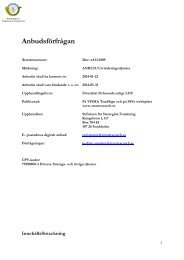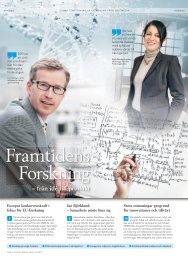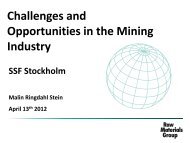Marcus Gavell
Marcus Gavell
Marcus Gavell
Create successful ePaper yourself
Turn your PDF publications into a flip-book with our unique Google optimized e-Paper software.
Gigabit Wave<br />
‘System on chip solutions for future high speed<br />
communication’<br />
Gigabit Wave project objectives:<br />
Hardware solutions for future<br />
short and medium range wireless communication links<br />
high data rate<br />
60‐300 GHz, with bit rates up to and above 10 Gb/s<br />
Project partners Chalmers, and Teledyne Thousand oaks<br />
Linköping University, Sivers IMA, Bitsim, Gotmic, Altera in MODEM‐project<br />
NXP on 60 GHz RX/TX 45 nm CMOS<br />
TU‐Berlin, HHI (Heinrich Hertz Institute) on 60 GHz NLOS‐MIMO<br />
Herbert Zirath / Thomas Swahn
Outline<br />
1. Motivation<br />
2. RFIC/MMIC processes for frequencies beyond 100 GHz<br />
3. Some circuit results<br />
4. Some system demonstrations<br />
5. Summary
Gigabit Wave Project Team<br />
Mattias Ferndahl<br />
<strong>Marcus</strong> <strong>Gavell</strong><br />
Thomas Swahn<br />
Rumen<br />
Kozhuharov<br />
Bertil<br />
Hansson<br />
Zhongxia<br />
Simon He<br />
Morteza<br />
Abbasi<br />
Yinggang<br />
Li<br />
Herbert<br />
Zirath<br />
Jingjing<br />
Chen<br />
Not in the picture: Vessen Vassilev, Ilcho Angelov,<br />
Photo: Jan‐Olov Yxell, Chalmers
Evolution of Wireless Multimedia Services<br />
• Wireless data rates<br />
increase tenfold every<br />
five years<br />
• WLANs and WPANs<br />
demand for rates<br />
beyond 1 GBit/s in the<br />
near future<br />
Courtesy Georg Boeck, boeck@tu-berlin.de, Berlin University of Technology
Gigabit Wave<br />
Develop future‐proof solutions<br />
Terabyte<br />
5 000 000<br />
4 000 000<br />
3 000 000<br />
2 000 000<br />
1 000 000<br />
0<br />
Mobile Access Traffic<br />
TV/Video<br />
Internet<br />
Voice<br />
2004 2005 2006 2007 2008 2009 2010 2011 2012<br />
Circuits and systems:<br />
•High speed<br />
•High frequency<br />
•Highly integrated<br />
Mobile Backhaul:<br />
• Gbps capacity needed for<br />
LTE (2010)<br />
• 2.5Gbps in a few years<br />
ahead<br />
• 10Gbps as fiber extension<br />
Yinggang Li, Ericsson Research
Challenges….<br />
high datarate ->high bandwidth ->high frequency:<br />
-60 GHz: unlicenced band 5 GHz, high attenuation, small distance, secure comm<br />
-E-band: 71-76, 81-86 licenced band for PtP 10 GHz BW<br />
-120 GHz: 20 GHz no standard today<br />
-220 GHz: 40 GHz no standard today<br />
•Very few commercial circuits exist for the frontend<br />
like LNA, mixer, LO, modulator, demodulator<br />
etc<br />
•Today’s most advanced semiconductor processes<br />
are needed for the realization of the hardware<br />
•No commercial back-end electronics exists<br />
•Spectrum efficiency<br />
•System simulation a challenge<br />
•Packaging
Evaluation and<br />
choice of IC<br />
Technologies<br />
System on chip solutions for future high speed<br />
communication<br />
Gigabit Wave project approach<br />
design of front‐end IC:s<br />
120 / 220 GHz<br />
mm‐wave transceivers<br />
Back‐end<br />
development and<br />
integration for<br />
System‐on‐Chip<br />
Goal<br />
Demonstration of 2 fully<br />
integrated and packaged<br />
wireless 10 Gb/s<br />
Ethernet‐compatible<br />
chipsets working in two<br />
bands: 120 GHz and 220<br />
GHz.<br />
Background in<br />
‐ NXP 60 GHz<br />
‐ E‐band 71‐76, 81‐86 GHz<br />
VINNOVA
Integration of mmW/THz‐Electronics…<br />
90-126 GHz<br />
0.01-8 GHz<br />
+20 dB -7 dB<br />
x2<br />
x2<br />
27.5 & 29.5 GHz<br />
RF<br />
HYBRID<br />
Single side band mixer
Gigabit Wave<br />
Generic demonstrator block diagram<br />
The backend electronics is developed in a VINNOVA-project, called MODEM<br />
Herbert Zirath / Thomas Swahn
Processes used at present in the program<br />
Teledyne Teledyne Teledyne TSMC<br />
Technology InP DHBT InP DHBT InP HEMT CMOS<br />
Feature size 500 nm 250 nm 50 nm 45 nm<br />
No.<br />
met.layers<br />
5 5 2 9<br />
Complexity MSI ‐ LSI MSI ‐ LSI 10 –50 VLSI<br />
f T /f MAX 330/360 GHz 400/700 GHz 600/600 GHz 300/300 GHz<br />
V BR VB CE0 = 4 V VB CE0 = 4 V 1 V 1 V<br />
120 GHz<br />
220 GHz<br />
120 GHz<br />
220 GHz<br />
340 GHz<br />
120 GHz<br />
220 GHz<br />
340 GHz<br />
60 GHz+
MET4<br />
Teledyne: TSCHBT 0.5/0.25 m InP DHBT<br />
Dielectric layers in BCB<br />
All Dimensions in µm<br />
BCB<br />
1.0<br />
3.0<br />
Denser integration possible, because<br />
the dielectric layers are 50 times smaller <br />
5‐10 times denser integration possible as<br />
compared to standard MMIC technology!<br />
Each layer is 2 m thick<br />
First design round, including 29 circuits and<br />
test structures, was completed during autumn<br />
2009. Evaluated during spring 2010.<br />
Second design round, including >100 circuits<br />
and test structures, was completed during<br />
spring 2011.<br />
2‐3 more tapeouts planned<br />
BCB<br />
BCB<br />
BCB<br />
MET1<br />
Substrate<br />
1.0<br />
CMET<br />
1.0<br />
MET3<br />
Representative cross‐section of TSCHBT IC technology.<br />
Drawing is not to scale. f t = 400 GHz, and f max = 700<br />
GHz @ J E = 5 mA/m 2<br />
3.0<br />
1.0<br />
CAPM<br />
TFRes<br />
MET2<br />
SiNx<br />
1.0<br />
1.0<br />
0.8<br />
SiO<br />
0.8<br />
6.8
3D MMIC technology<br />
Pioneering work was done by NTT since beginning of 1990....
Gigabit Wave<br />
Teledyne 500 nm InP DHBT, tapeout #1<br />
Reticle<br />
taped‐out<br />
autumn<br />
2009<br />
First design<br />
round,<br />
including 29<br />
circuits and<br />
test<br />
structures,<br />
was<br />
completed<br />
during the<br />
autumn<br />
2009.<br />
NOTE: This slide should be<br />
updated with an image of<br />
the reticle from our first<br />
TSCHBT tape‐out.<br />
Herbert Zirath / Thomas Swahn
Gigabit Wave<br />
Some MMICs in Teledyne tapeout #1<br />
•Up converting Gilbert mixer<br />
(CG =11 dB, BW = 85‐100 GHz)<br />
•Down converting Gilbert mixer<br />
(CG =2 dB, BW = 85‐100 GHz)<br />
•Active balun<br />
(CG= 0‐8 dB, BW = 15‐120 GHz)<br />
•Differential buffer amplifier<br />
(A = 10 dB, BW = 90‐130 GHz, OP1dB = 10 dBm)<br />
<strong>Marcus</strong> <strong>Gavell</strong>, et al,’ A fundamental upconverting Gilbert mixer for 100 GHz<br />
wireless applications, 32nd IEEE COMPOUND SEMICONDUCTOR IC (CSIC)<br />
SYMPOSIUM , 3-6 October 2010, Monterey, USA.<br />
<strong>Marcus</strong> <strong>Gavell</strong>
Teledyne tapeout #2<br />
50 nm InP HEMT Tapeout May 2010 test round<br />
•Test devices for modeling and designkit<br />
•Single‐ended resistive mixers<br />
•W‐ and G‐band LNAs<br />
•120 GHz OOK‐modulator<br />
•220 GHz OOK‐modulator<br />
•Frequency Tripler ‐ 30 to 100 GHz<br />
•220 GHz Antenna‐Integrated mixers<br />
•100‐220 GHz power detector<br />
•100‐220 GHz envelope detector (10 Gbps)<br />
A designkit was made for this process including scalable nonlinear HEMT model<br />
Majority of circuits works well, several publications ahead<br />
One possible patent on antenna integrated mixer
Wireless system demonstrations<br />
1. 12.5 Gbps OOK short range link at 220 GHz<br />
2. NLOS MIMO at 60 GHz 500 Mbps<br />
3. 5 Gbps at E-band with D-QPSK
Gigabit Wave<br />
System level<br />
experiments are made<br />
on our latest receiver<br />
module (IAF 100nm<br />
mHEMT) to<br />
demonstrate the<br />
feasibility of 12.5Gbps<br />
wireless data<br />
transmission at<br />
220GHz.<br />
220 GHz<br />
Single‐Chip<br />
Heterodyne<br />
TX‐RX with<br />
integrated<br />
antenna<br />
Morteza Abbasi, et al,, Single-Chip 220 GHz Active Heterodyne Receiver and<br />
Transmitter MMICs with on-Chip Integrated Antenna, IEEE Trans. MTT 2011<br />
Morteza Abbasi
Gigabit Wave<br />
Advanced mm‐wave module for 100+ GHz MMICs<br />
•Verified performance up to 110 GHz<br />
•High performance Waveguide to<br />
microstrip transitions<br />
•Possibility to integrate multiple chips<br />
•First demonstion of 60 GHz MIMO NLOS<br />
in collaboration with Heinrich Hertz<br />
Institute/TUB using these modules<br />
0.05mm TP+<br />
0.1mm TP+<br />
0.5mm<br />
Cu<br />
<strong>Marcus</strong> <strong>Gavell</strong>
Gigabit Wave<br />
World 1 st Demo of 60GHz NLOS STC‐MIMO System<br />
We demonstrated world 1 st<br />
Non‐Line‐Of‐Sight MIMO System on ICC’09 with HHI<br />
• 2x2 MIMO with Space‐time‐coding<br />
• Transmitting continue when direct path is blocked<br />
•Data rate: 250 Mbps<br />
• Real time HDTV video transmission<br />
• Transmission distance: 10m<br />
Cooperating Partner:<br />
• Heinrich Hertz Institute (HHI):<br />
Signal Processing<br />
•MEL, Chalmers<br />
60GHz MMIC‐chipset and RF module design<br />
•TU Berlin<br />
CMOS multifunction RFIC<br />
International Conference on Communication 2009<br />
Dresden Germany<br />
Zhongxia (Simon) He, <strong>Marcus</strong> <strong>Gavell</strong>
Image reject receiver<br />
1st chip set for 60 GHz radio made at Chalmers<br />
University in pHEMT technology (WIN PP-15)<br />
RFin<br />
56‐64 GHz<br />
RF amplifier<br />
Image reject<br />
mixer<br />
Baseband out<br />
2.5 GHz CF<br />
Experimental data<br />
LO 6.7‐7.7 GHz<br />
X8 frequency multiplier+buffer<br />
RFout<br />
56‐64 GHz<br />
5.7x5 mm<br />
Transmitter<br />
Balanced mixer w.<br />
high LO‐rejection<br />
8 dB RF-IF gain<br />
>25 dB image rejection<br />
56-64 GHz RF bandwidth<br />
>1.5 GHz IF bandwidth<br />
Baseband in<br />
2.5 GHz CF<br />
See IEEE JSSC Nov 2005<br />
5x3.5 mm<br />
LO 6.7‐7.7 GHz
5Gbps demonstrator<br />
5GB E-band radio demonstrator<br />
› Joint-research with MEL, Chalmers<br />
› Demonstrator Technology<br />
– Link capacity: 5Gbit/s full-duplex<br />
– Frequency: 71-76GHz & 81-86GHz (E-band)<br />
– Modulation: Differential-QPSK<br />
– All-outdoor unit with dual-channel STM-16/OC-48 optical interface<br />
› Future-proof microwave backhaul solution for LTE and beyond<br />
Lab test-bench<br />
81-86GHz 5Gbit/s<br />
71-76GHz 5Gbit/s<br />
Public Demo at MWC2011<br />
Mobile World Congress, Barcelona<br />
Ericsson Internal | 2011-01-23 | Page 21<br />
Simon He, Jingjing Chen
Gigabit Wave<br />
Mapping of our activities onto SSF’s evolution plot<br />
E‐band<br />
220 GHz<br />
60 GHz<br />
120 GHz
Summary
Circuit Design and Fabrication up to 340 GHz<br />
3.5 mm x 1 mm<br />
1.5 mm x 1 mm<br />
2.75 mm x 1.75 mm<br />
130µm x 300 µm<br />
350µm x 650 µm
Packaging and Interfacing<br />
60GHz receiver / transmitter<br />
118GHz low‐noise heterodyne receiver<br />
Input @ f0<br />
25GHz ‐35GHz<br />
Pin=7dBm<br />
Power<br />
Amplifier Output @ 6xf0<br />
X 3 X 2<br />
150GHz ‐195 GHz<br />
Pout=5dBm<br />
180GHz integrated signal source<br />
220GHz low‐noise heterodyne receiver / transmitter with integrated antennas
System Level Measurements & Demonstrations<br />
7.5 GSps QPSK<br />
(=15 Gbps)<br />
1m @ 60GHz<br />
12.5 Gbps BPSK<br />
0.5m @ 220GHz
Thank You for listening !
Gigabit Wave<br />
WIN 150nm mHEMT<br />
E‐band circuits<br />
•Low Noise Amplifiers<br />
NF=4.5 dB, Gain=23 dB,<br />
•IQ modulator (Accepted IMS 2010)<br />
Side‐band suppression >= 20 dB, IIP3=20dBm<br />
•Image Reject Mixer (Presented CSICS 2009)<br />
Image‐Rejection Ratio >= 20 dB<br />
•Multipliers (x8)<br />
•Gotmic AB (spin‐off 2008) uses WIN for E‐band circuits<br />
S 21<br />
[dB]<br />
30<br />
20<br />
10<br />
Bias 1<br />
Bias 2<br />
0<br />
70 75 80 85 90<br />
Freq [GHz]<br />
CL/SBS [dB]<br />
40<br />
30<br />
20<br />
10<br />
IF=1GHz<br />
SBS=1GHz<br />
IF=5GHz<br />
SBS=5GHz<br />
Total RF output power [dBm]<br />
20<br />
0<br />
-20<br />
-40<br />
-60<br />
f LO<br />
+f IF1<br />
f LO<br />
+2*f IF1<br />
-f IF2<br />
f LO<br />
+3*f IF1<br />
-2*f IF1<br />
0<br />
60 70 80 90 100<br />
LO frequency [GHz]<br />
-80<br />
-10 0 10 20<br />
Total IF input power [dBm]<br />
<strong>Marcus</strong> <strong>Gavell</strong>



